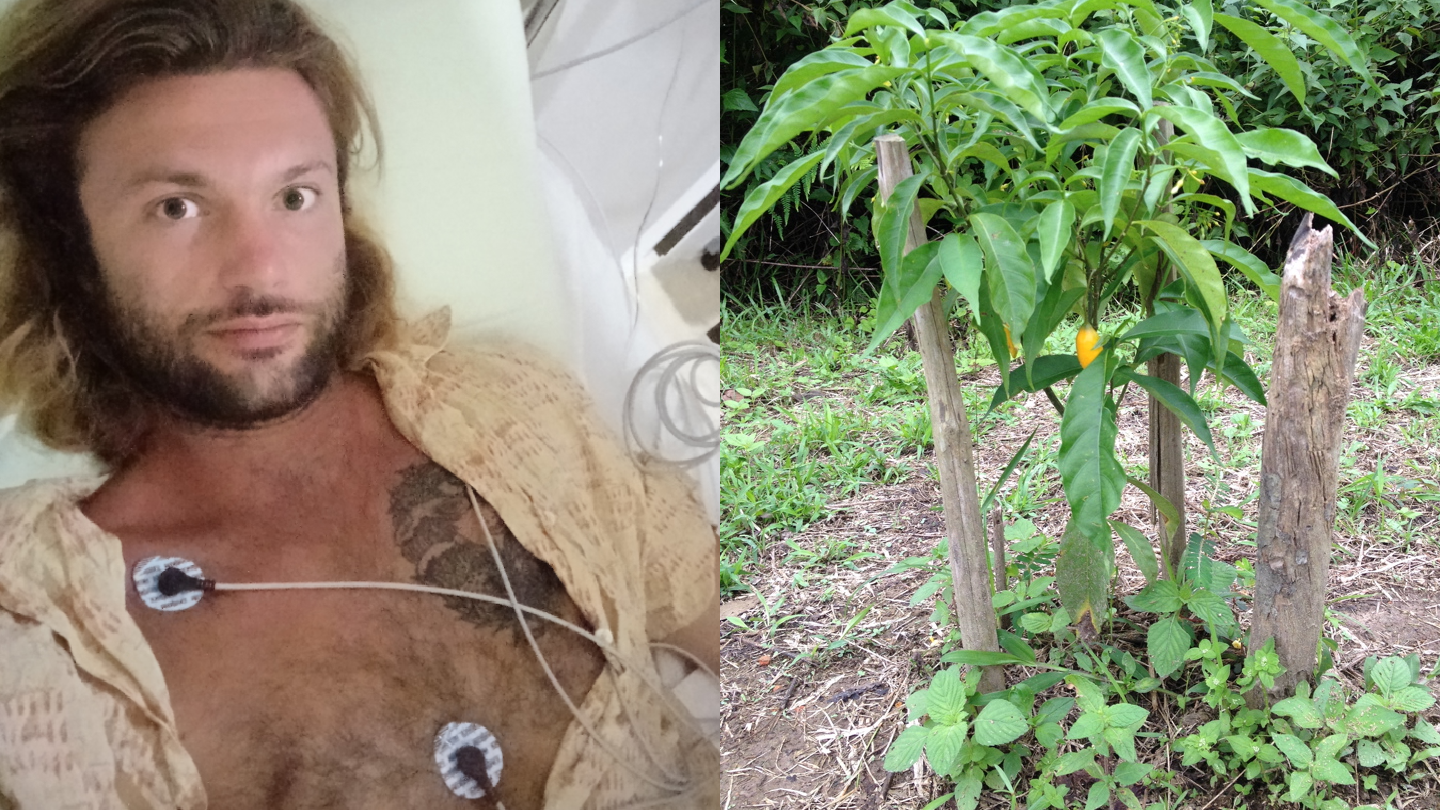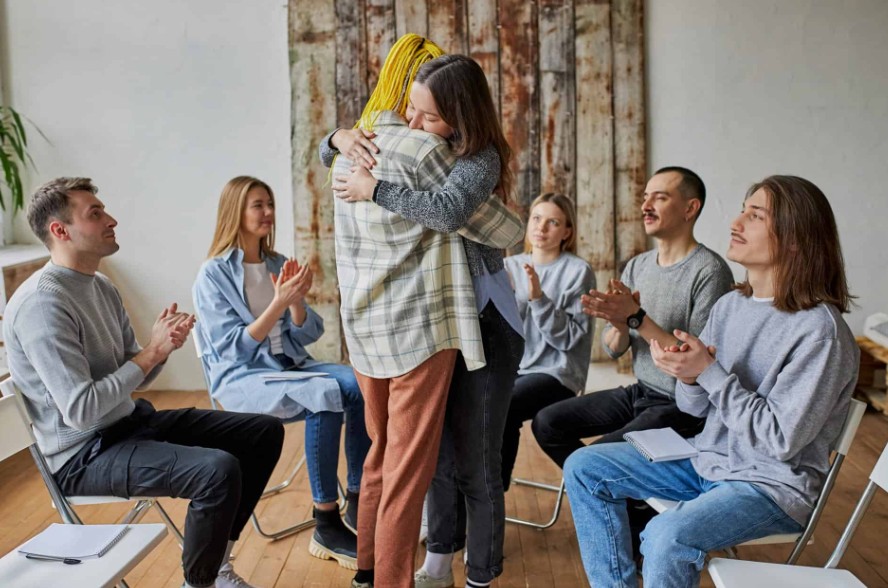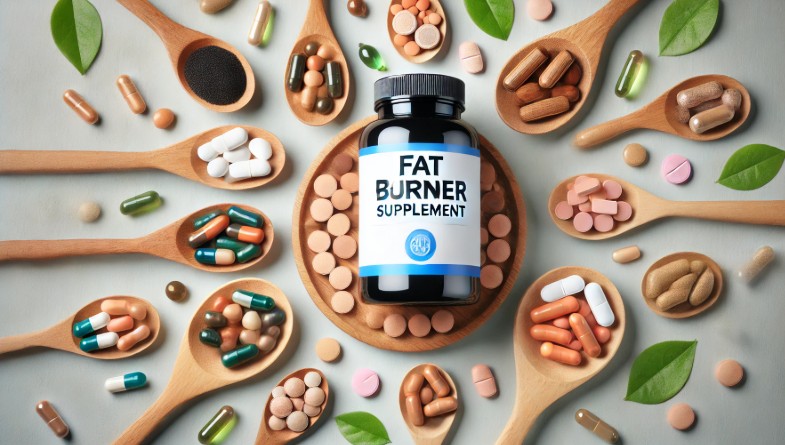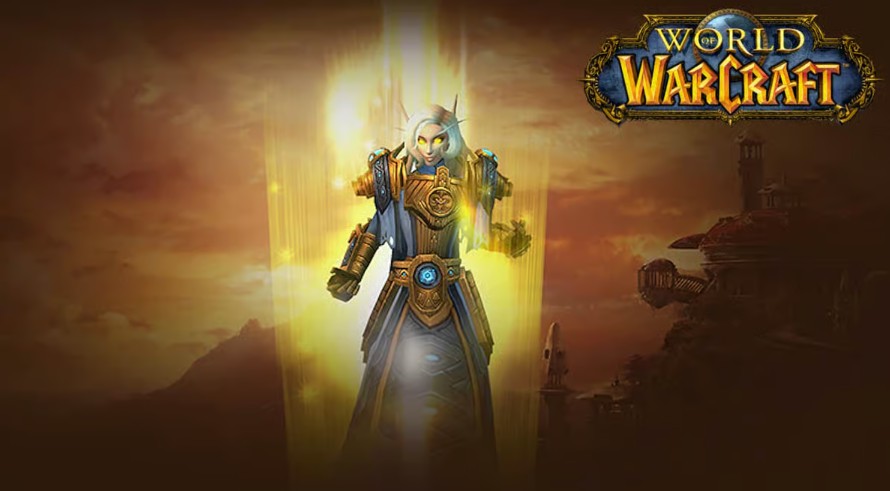
The author in the ibogaine clinic bed; the iboga plant. Photo: courtesy of author and Chor Boogie
A needle connected to an IV drip pierces one of my veins, a band strapped around my left bicep monitors my heart rate, and a clip on my right index finger also tracks my pulse as I lie on a hospital bed in a sterile clinic at 9AM. It sounds like I’m about to undergo surgery. I have, in fact, swallowed nine capsules containing ibogaine, a psychedelic compound extracted from a Gabonese root bark used in coming-of-age rituals that often feature intense visions as part of vivid, sometimes autobiographical, all-night visions.
Soon the trip starts: images of the solar system punctuated by clips of my younger self laughing, then a bizarre internal reel made up of Jesus Christ, an alien and an image of a bush – seemingly the one from which the medicine derived. These eventually give way to a pounding narrative of negative thoughts known as a “mind-purge”.
After more than 12 hours in the clinic bed – of which six fly by in a flash – I am unhooked from the machinery and the headphones that have been emitting an obscure mix of African music, Pink Floyd and European techno. I stay awake all night in a rolling state of bliss and gratitude as the tears flow.
Most people come to Beond, an ibogaine clinic based out of a mansion in Cancun, Mexico, to get off drugs, including prescribed opioid painkillers, heroin, fentanyl and meth. I have been invited here by the owner after I expressed disbelief that ibogaine could immediately eliminate drug withdrawal symptoms.
“I have treated more than 2,000 patients with ibogaine over 17 years and the relapse rate is about 50 percent in the long term, but around 85 percent of people leave the clinic without withdrawals and cravings,” Dr Felipe Malacara MD, the chief clinical operations director, says.
In my eight days in Cancun, I witness people who claim to have been previously dependent on drugs enjoying astonishingly swift uplifts in their fortunes. Michael, from the US, underwent his trip at the same time as me. Until he arrived at the clinic, the 33-year-old, who did not want his surname made public, told me he had been regularly injecting copious amounts of fentanyl, as well as taking crystal meth and benzos. I’d previously only exchanged a few words with him – that was the extent of his anxiety and withdrawal symptoms, despite receiving substantial doses of morphine.
But the day after our treatments Michael is doing yoga, smiling and chatting with no visible withdrawal symptoms. He had undergone rehab at dozens of other facilities previously without losing the desire for drugs. “The light is back in my eyes,” he remarks. “I came in completely closed off and isolated.”
Ibogaine seems to swiftly reset the neural pathways in the brain like no other psychedelic through the process of (sometimes distressing) trips that can last as long as 36 hours. This may play a role in eliminating the drug cravings that develop within people over time. This same “resetting” has also led many US veterans to claim they have successfully treated their PTSD with the drug. Others, like me, work with it for psycho-spiritual purposes.
Another American patient I met, Richard, told me he had taken heavy doses of opioids every day for 10 years after becoming dependent at a hospital following surgery. “It caused me to lose jobs and some of my closest friends, and to nearly lose my wife,” he says.
He too was soon free of debilitating cravings – with just weirdly incessant yawning and mild anxiety persisting for a few days after his trip. “A small price to pay for ending a decade of opiate dependence,” he says. The 60-year-old joked and giggled as he received a pedicure days after his ibogaine trip. The next day he enjoyed a blissful aguahara session, where participants are cradled in a pool. It seemed to me unimaginable either Michael or Richard would have engaged with such activities prior to their treatment.
The idea of effectively undergoing ten years of therapy in one night, promulgated by writer Daniel Pinchbeck – author of Breaking Open the Head – seems almost too good to be true, but positive anecdotal reports are mounting.
“Ibogaine is not a magic bullet, but it can spell the beginning of a process of healing,” says Malacara. “But then it is down to the patients, they have to be willing to change their environment and lifestyle back home.”
It was in 1962 that ibogaine’s unique anti-addiction effects were discovered, by 19-year-old Howard Lotsof who was at the time dependent on heroin and experimenting with other drugs. At the suggestion of a chemist he knew, he consumed ibogaine. “Suddenly, I realised that I was not in heroin withdrawal,” he later said. “Where previously I had viewed heroin as a drug which gave me comfort, I now viewed heroin as a drug which emulated death. The very next thought into my mind was, ‘I prefer life to death.’”
Despite the compelling tales of addiction recovery, films detailing swift recovery from serious addiction (including one broadcast on the BBC), scientific studies and observational trials, the pharmaceutical industry has shown little interest in supporting the high-quality research that could bring the drug to the mainstream. Notably, however, the medicine has been legal in New Zealand since 2009 after authorities acknowledged it is “reported to alleviate the symptoms of opiate withdrawal”.
As I sit in the clinic recovering from my trip, I begin reading one of the books on the coffee table, Heart Medicine: A True Love Story – One Couple’s Quest for the Sacred Iboga Medicine & the Cure for Addiction. It’s written by Elizabeth Bast, whose artist husband Chor Boogie had relapsed into heroin and alcohol use after a period sober following long-term dependency.
Their story culminates in a ceremony in Costa Rica where the couple consumed iboga – the powerful plant from which ibogaine derives, and which is generally considered stronger. I race through it like no other book in years.
The author with Chor Boogie at the retreat centre. Photo: Patrick Fishley
I message Bast a week later to thank her and express how the book helped me process my psychedelic experience. She says that since going to Gabon more than a decade ago to train in the Indigenous tradition of the Babongo people, the discoverers and primary custodians of the medicine, she and Boogie now hold retreats themselves. She invites me to one to experience the effects of the raw, unprocessed plant, and I accept.
Soon enough, I am at their SoulCentro retreat centre in Costa Rica eating a horrific tasting mixture of the iboga root bark with honey. As incessantly uptempo tribal music blares from the speaker – it is said by Gabonese people that the beat of the bongos helps rewire the brain – Boogie takes me on a so-called soul journey that results in a conversation and hug with my late aunt, but then degenerates into a severe state of frustration and paranoia. It seems these deep-seated feelings are what I need to purge in order to be happier.
“Iboga can connect people with their souls and dead relatives,” the renowned spray paint artist tells me. “It takes you to the point where you’re literally getting answers to your life. Iboga wakes people up from the Matrix, it’s like taking the red pill. I never looked back after my first time and haven’t consumed alcohol, done drugs or even drank coffee since.”
The long term success of therapy with ibogaine and iboga in overcoming drug dependency ranges from about 50–75 percent, and depends on the quality of after care and integration, plus the number of trips undertaken. This compares to about 10 percent through the traditional avenues for addiction.
Fletcher Burdick visited SoulCentro a year ago to consume iboga in an effort to overcome his heroin addiction, which developed from his taking prescription opioids as a 17-year-old. Over a 15-year period, he – like Boogie – had tried everything from a whole host of psychedelic drugs like DMT and mescaline, various types of rehab and different kinds of detoxes to overcome his debilitating dependency.
He tells me he had always been trying to drown out something within himself – to avoid facing reality – ever since his parents’ acrimonious divorce when he was a young child. “I was deteriorating from the inside out,” Burdick says. “I feared death. I had become so out of touch with myself that it was no longer manageable. I was 120 pounds, my skin was grey, my eyes were cloudy, and it was just a miserable, lonely place to be in.”
Burdick, from California, recalls that iboga induced a vision which allowed him to look inside himself and witness “the pure chaos, anxiety and darkness” that lived tightly wound inside of him. “Then, the medicine carried out a total mental detox of my brain and decluttered it all,” he says. For the first time, I felt peaceful and calm.” A year later, after rigorous integration work and structured support, he remains sober and is happier than ever.
Chor Boogie’s ibogaine altar in Costa Rica. Photo: courtesy of Chor Boogie
He is just one of a growing number of Americans turning to this lesser-known psychedelic in an attempt to come off of opiates as the country’s deadly overdose crisis worsens. More than 100,000 Americans died from overdoses last year, mostly having used synthetic opioids. However, both iboga and ibogaine remain classified as Schedule I controlled substances in the US, alongside heroin and ecstasy.
Both iboga and ibogaine pose significant clinical risks and some have died following their use, mostly due to cardiac arrhythmia – though this has often been down to poor facilitation, failure to conduct the precautionary health checks or to ensure proper detoxing from drugs. That makes comprehensive pre-trip screening crucial, and people must be monitored throughout.
“Ibogaine, in its pure chemical form or as a constituent of iboga, has clinically significant effects on physical dependence on opioids and craving for substances of abuse,” says Kenneth Alper MD, an associate professor of psychiatry and neurology at NYU School of Medicine and the author of widely cited papers on ibogaine for leading scientific journals.
“But it doesn’t act like mainstay conventional treatments such as methadone or buprenorphine, which act by substituting for opioids – ibogaine’s mechanism of action is unknown, which is what is so interesting about it. In my opinion it’s the most compelling pharmacological paradigm of my generation.” People who have undergone trips with the psychedelic typically view recovery in spiritual terms, he adds: “They invoke God or a higher power.”
Ibogaine and iboga have yet to undergo rigorous scientific testing, partly because both are still illegal in the US. As Alper points out, how they work to undo dependency also remains unknown, though an ibogaine fMRI study at Stanford University is currently in its final stages after imaging the brain under the influence of the drug for the first time in a trial.
“It may take some time to fully understand what ibogaine may offer towards the investigation of the neurobiology of addiction and the development of new treatment,” acknowledges Alper.
He remains skeptical over whether such treatments could be rolled out properly on a mass scale, in part due to the nature of the healthcare system. “I would be concerned about using it on a large scale, simply because to do ibogaine treatments well and safely requires a lot of screening, monitoring and knowledge,” Alper says. “I’m not so sure that this can be done widely without compromising.”
Funnily enough, I actually did have a vision of Christ’s crucifixion, complete with a crown of thorns. Maybe it was just a memory from a movie – but almost five months on from the final ceremony I feel more grateful than ever to be alive.







